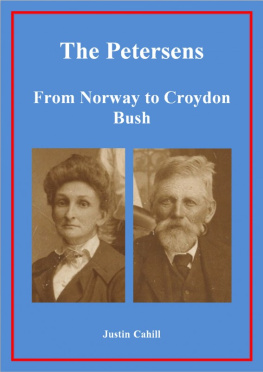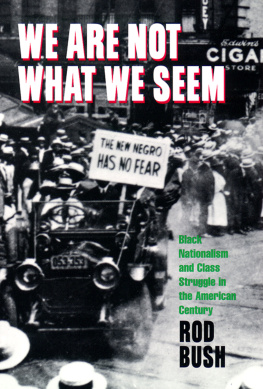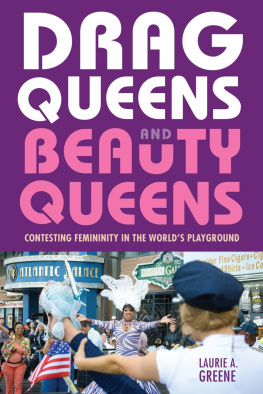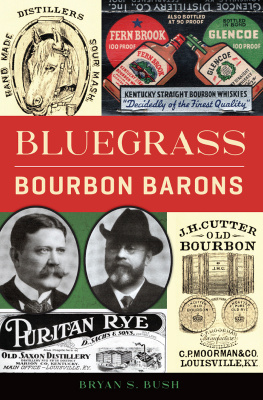THE QUEENS BUSH SETTLEMENT
Black Pioneers 1839-1865
LINDA BROWN - KUBISCH
Copyright 2004 Linda Brown-Kubisch
All rights reserved. No portion of this book, with the exception of brief extracts for the purpose of literary or scholarly review, may be reproduced in any form without the permission of the publisher.
Published by Natural Heritage / Natural History Inc.
P.O. Box 95, Station O, Toronto, Ontario M4A 2M8
www.naturalheritagebooks.com
National Library of Canada Cataloguing in Publication
Brown-Kubisch, Linda
The Queens Bush Settlement: Black pioneers, 1839-1865 /
Linda Brown-Kubisch.
Includes bibliographical references and index.
ISBN 1-896219-85-3
1. Blacks Ontario Waterloo (County) History19th century.
2. Blacks Ontario Wellington (County) History19th century.
3. Queens Bush Settlement (Ont.) I. Title.
FC3100.B6B76 2004 971.34400496 C2003-905508-6
Cover and text design by Sari Naworynski
Edited by Jane Gibson
Printed and bound in Canada by Hignell Book Printing, Winnipeg
Front cover photo: Crumbling tombstones in what is left of the Peel
Township AME/BME Cemetery. Photo by Linda Brown-Kubish.
Back cover photo: Courtesy of the Wellington County Archives.
Natural Heritage / Natural History Inc. acknowledges the financial support of the Canada Council for the Arts and the Ontario Arts Council for our publishing program. We acknowledge the support of the Government of Ontario through the Ontario Media Development Corporations Ontario Book Initiative. We also acknowledge the financial support of the Government of Canada through the Book Publishing Industry Development Program (BPIDP) and the Association for the Export of Canadian Books.
For Michael, Nicholas and Kaitlin.
With a special thank you to Ian Easterbrook.T ABLE OF C ONTENTS
A CKNOWLEDGEMENTS
Over the years I have incurred many debts. Many people have generously helped me in all phases of this book. I am particularly indebted to Susan Hoffman and Ryan Taylor, my former colleagues at the Grace Schmidt Room of Local History at the Kitchener Public Library, Kitchener. It was their encouragement and help that enabled me to begin this research project. During my research trips to Kitchener, Pat and Reinhold Kauk opened their home to me, for which I am truly grateful. Doing research long distance is always difficult, but whenever I needed a local source checked Francis Hoffman provided the information. Lisa Lee, Melba Jewell, Pat Jewell and Ted Jewell graciously shared their memories and knowledge of their ancestors with me. Ian Easterbrook, past-President of the Wellington County Historical Society, has remained a constant source of encouragement and was extraordinarily generous in sharing his own research material with me. Ian and Katherine Lamb also read the manuscript and made many useful suggestions. Any errors, factual or interpretive, however, are purely my own.
My research was aided immeasurably by helpful staffs at many different libraries, archives, and historical societies in the United States and in Canada. I am greatly indebted to the staff of the Inter-library Loan Department at Ellis Library, University of Missouri-Columbia, who were resourceful in locating and securing for me many sources. My gratitude must particularly go to the staffs of the Kitchener Public Library, Kitchener; the Wellington County Museum and Archives, Fergus; the Wellesley Historical Society, Wellesley; the Canadian Baptist Archives, Hamilton; the Regional History Collection, D.B. Weldon Library, University of Western Ontario, London; North American Black Historical Museum and Cultural Centre, Amherstburg; the Buxton National Historic Site and Museum, North Buxton; the John Freeman Walls Historic Site, Maidstone Township; the Amistad Research Center, New Orleans; the Maine Historical Society, Portland; the New Hampshire Historical Society, Concord; and the Rembert E. Stokes Learning Resources Centre, Wilberforce University, Wilberforce, Ohio.
Parts of first appeared as articles in Wellington County History and Ontario History, and are used with their editors permission. Finally, I would like to acknowledge the Amistad Research Center and the New Hampshire Historical Society for permission to quote from their manuscript collections.
My greatest debt, however, is to my family, who suffered through my graduate studies and then tolerated my continued interest in the Queens Bush as I completed the manuscript. My husband, Michael, undertook the formidable task of editing the original manuscript. His ruthless pen and keen judgment greatly improved the work. My son, Nicholas, and my daughter, Kaitlin, have my sincere thanks many times over.
P REFACE
Nestled in the rural countryside of Wellington County near Glen Allen is a small abandoned cemetery, known as the Peel Township Black Cemetery. There are probably hundreds of graves in this cemetery, but natural weathering, neglect and vandalism have destroyed most of the stones. Only a few are remaining and even those are almost unreadable. Years ago the broken stones were mended with iron rods, that have now rusted, and then set in a slab concrete in a straight line. While well-meaning, the attempt to restore the tombstones probably contributed even more damage to the crumbling stone. These gravemarkers are the only physical reminder of a once thriving and important Black community known as the Queens Bush.
Walking through the cemetery causes one to wonder what the community was like. How did it originate and what caused it to fade away? I became interested in the Queens Bush while employed at the Kitchener Public Library in Kitchener, Ontario. The staff of the Grace Schmidt Room of Local History frequently received queries about the communitys inhabitants, especially those who had been fugitive slaves. Because of this experience, my interest began to focus on the fate of fugitive slaves in Ontario, which developed first into an article then into a thesis for a masters degree in history. Still fascinated by the topic, I expanded my thesis into a work suitable for publication.
When I began my research on the Queens Bush, I questioned how much information I would be able to locate. Previously published references to the community indicated that few documents would be available, because most fugitive slaves had never had schooling opportunities and thus were illiterate and incapable of leaving written records. Indeed, very few residents of the Queens Bush left correspondence or other documents, which could tell of their experiences in their new homeland. Moreover, very few American abolitionists, who travelled to the province, actually visited the community not because the community was unknown, but because the frontier settlement was north of the more southerly transportation routes. Roads leading into the settlement were little more than wilderness trails and were impassable during most of the year. One consequence of this invisibility is that the residents of the Queens Bush have been ignored throughout history, although they represented one of the largest Black communities of its time. Until now, the Queens Bush has only been briefly mentioned in historical accounts of the Black experience in Ontario. More attention has focused on the organized communities of Wilberforce, the British-American Institute, the Elgin Settlement and the Refugee Home Society.














